Understanding Retail Data: Definition, Importance, and Types
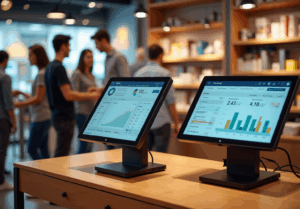
Understanding Retail Data: Definition, Importance, and Types
Overview
The article centers on the definition of retail data, highlighting its significance and the various types that exist within the retail landscape. Retail data is a crucial feature for optimizing operations and enhancing customer experiences. It provides valuable insights into consumer behavior, inventory management, and market trends. The advantages of utilizing retail data enable retailers to make informed decisions, ultimately improving their strategies. By leveraging these insights, retailers can better align their offerings with customer needs, leading to increased satisfaction and loyalty.
How can your business harness the power of retail data to drive success?
Introduction
Retail data serves as the backbone of modern commerce, capturing a wealth of information from every transaction and interaction within the retail landscape. This critical data offers features such as insights into sales performance and consumer behavior, which are advantageous for businesses aiming to fine-tune their strategies. The benefits of effectively harnessing this data include enhanced customer satisfaction and loyalty. However, as the retail environment evolves rapidly, companies must consider:
- How can they navigate shifting consumer preferences and market dynamics?
- Understanding the nuances of retail data—its definition, significance, and various types—becomes essential for retailers aiming to thrive in an increasingly competitive marketplace.
Define Retail Data: Key Concepts and Components
Retail data includes the details collected from various transactions and consumer interactions within the retail environment. This data includes essential metrics such as revenue statistics, client demographics, inventory levels, and buying patterns. Notably, point-of-sale (POS) information captures transaction details at the moment of sale, providing immediate insights into sales performance. Additionally, client information reveals consumer preferences and purchasing patterns, which are crucial for customizing marketing strategies and enhancing service delivery.
The significance of retail data in enhancing client experience is paramount. For instance, the efficient use of POS information allows sellers to recognize trends and adjust inventory accordingly, ensuring that favored items are consistently available. A recent study indicates that 93% of sellers are utilizing automation for inventory management, which directly correlates with enhanced client satisfaction. Furthermore, market analysts emphasize that merging client information with sales metrics can create a more tailored shopping experience, ultimately fostering loyalty and boosting sales. Importantly, loyalty program engagement information accounts for 55%, aiding merchants in rewarding and retaining devoted clientele.
In summary, understanding the components of retail data, particularly POS statistics, is essential for retailers aiming to optimize operations and enhance customer experiences. By leveraging these insights, businesses can make informed decisions that align with consumer expectations and market trends. As the retail analytics sector is projected to grow from USD 8.75 billion in 2024 to USD 31.08 billion by 2032, the importance of effective information management and analysis solutions will only continue to rise.
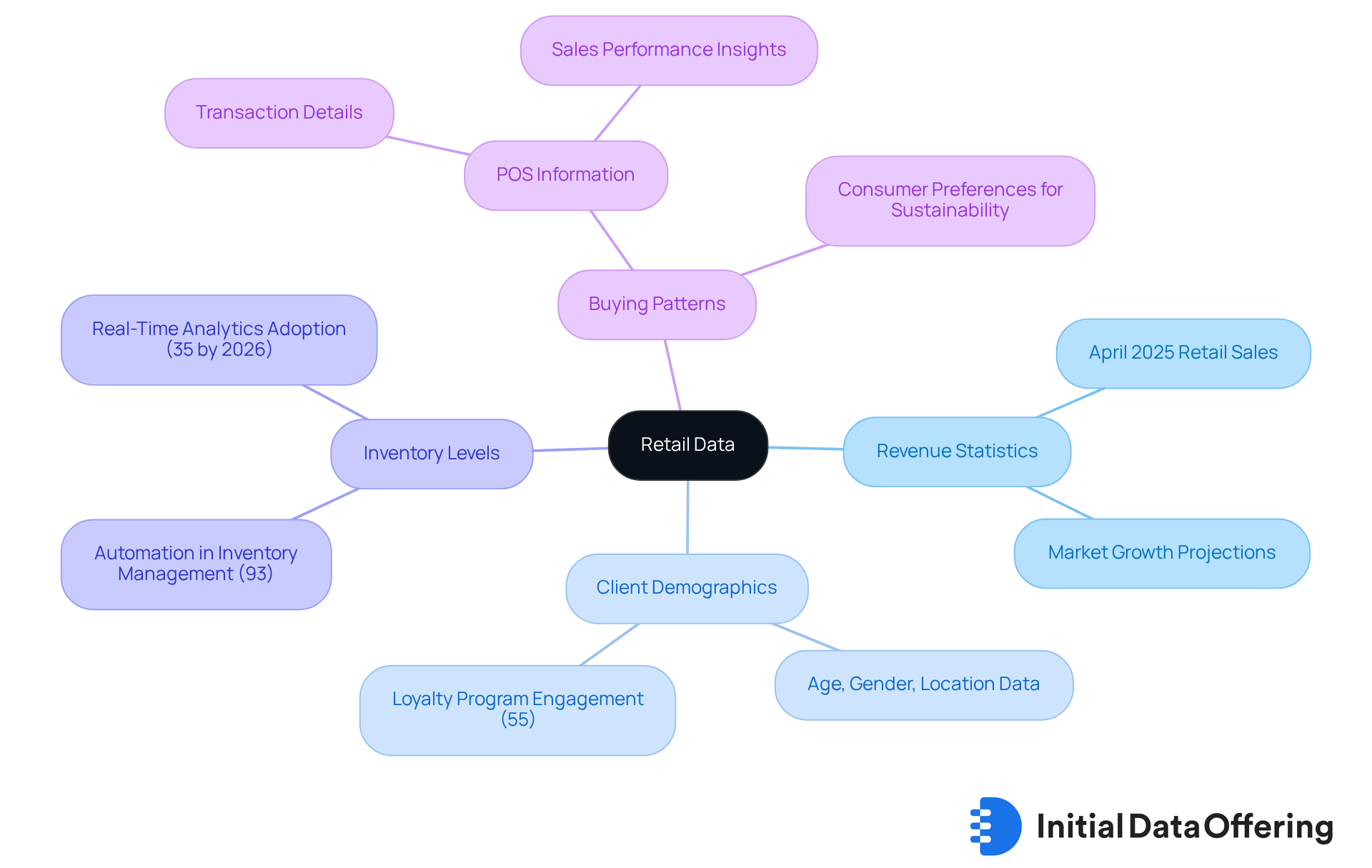
Contextualize Retail Data: Importance in Market Research
Retail data plays a crucial role in market research by offering businesses valuable insights into consumer behavior and prevailing market trends. By examining retail data, companies can uncover purchasing patterns, anticipate demand, and refine their marketing strategies to better align with consumer preferences.
For instance, merchants can leverage retail data to identify top-performing products, which enables them to efficiently adjust inventory levels. Furthermore, insights into customer demographics derived from retail data facilitate audience segmentation, empowering businesses to develop targeted marketing campaigns that enhance customer engagement and loyalty.
This approach not only boosts revenue but also fosters a deeper understanding of consumer motivations, ultimately leading to more informed decision-making.
How can businesses leverage these insights to stay ahead? Recent studies indicate that effective segmentation and real-time analytics using retail data are essential for adapting to shifting consumer behaviors, ensuring that retailers remain competitive in a rapidly evolving marketplace.
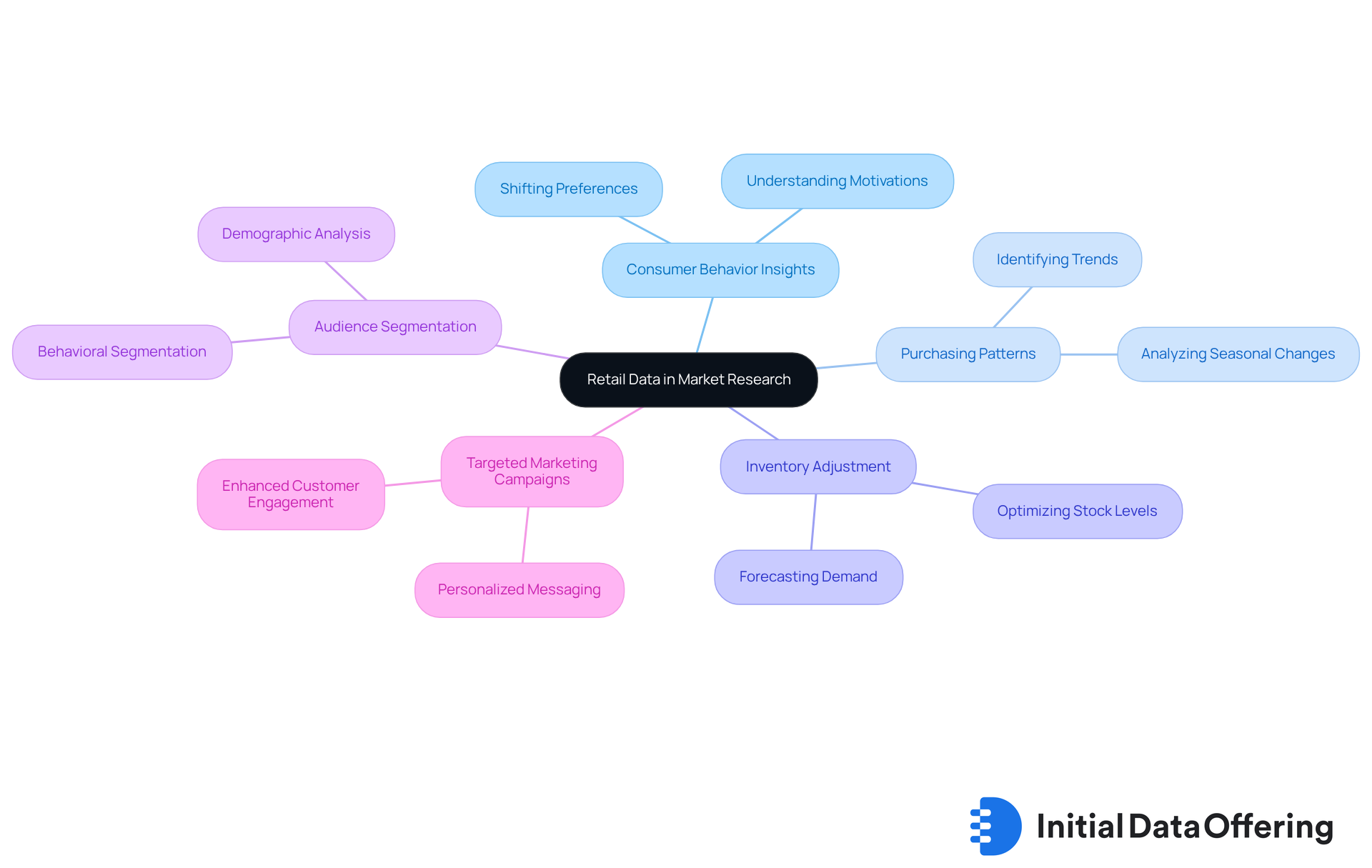
Trace the Evolution of Retail Data: Historical Background and Development
The evolution of retail information is rooted in the early days of commerce, when merchants depended on manual record-keeping to monitor sales and inventory. The introduction of technology, particularly point-of-sale (POS) systems in the late 20th century, significantly advanced the gathering and analysis of retail data. This transition from mechanical cash registers to electronic POS systems not only improved transaction processing speed but also enhanced accuracy. The rise of e-commerce further accelerated this transformation, enabling online sellers to amass extensive retail data regarding consumer behavior.
In 2023, POS terminals in the U.S. generated $6.89 billion in revenue, with projections indicating a rise to $9.86 billion by 2030. This underscores the rapid growth of retail technology and its implications for the industry. Today, advanced analytics and machine learning techniques empower retailers to process and interpret retail data in real-time, fostering informed decision-making and enhancing customer experiences.
As Melissa Chen observes, 'From the early electronic cash registers of the 1970s to today’s cloud-based, mobile tablets, point of sale (POS) systems have undergone a dynamic evolution over the past half century.' This technological advancement not only highlights the critical role of retail data in shaping retail strategies but also enhances operational efficiency.
How can your organization leverage these insights to optimize its retail operations?
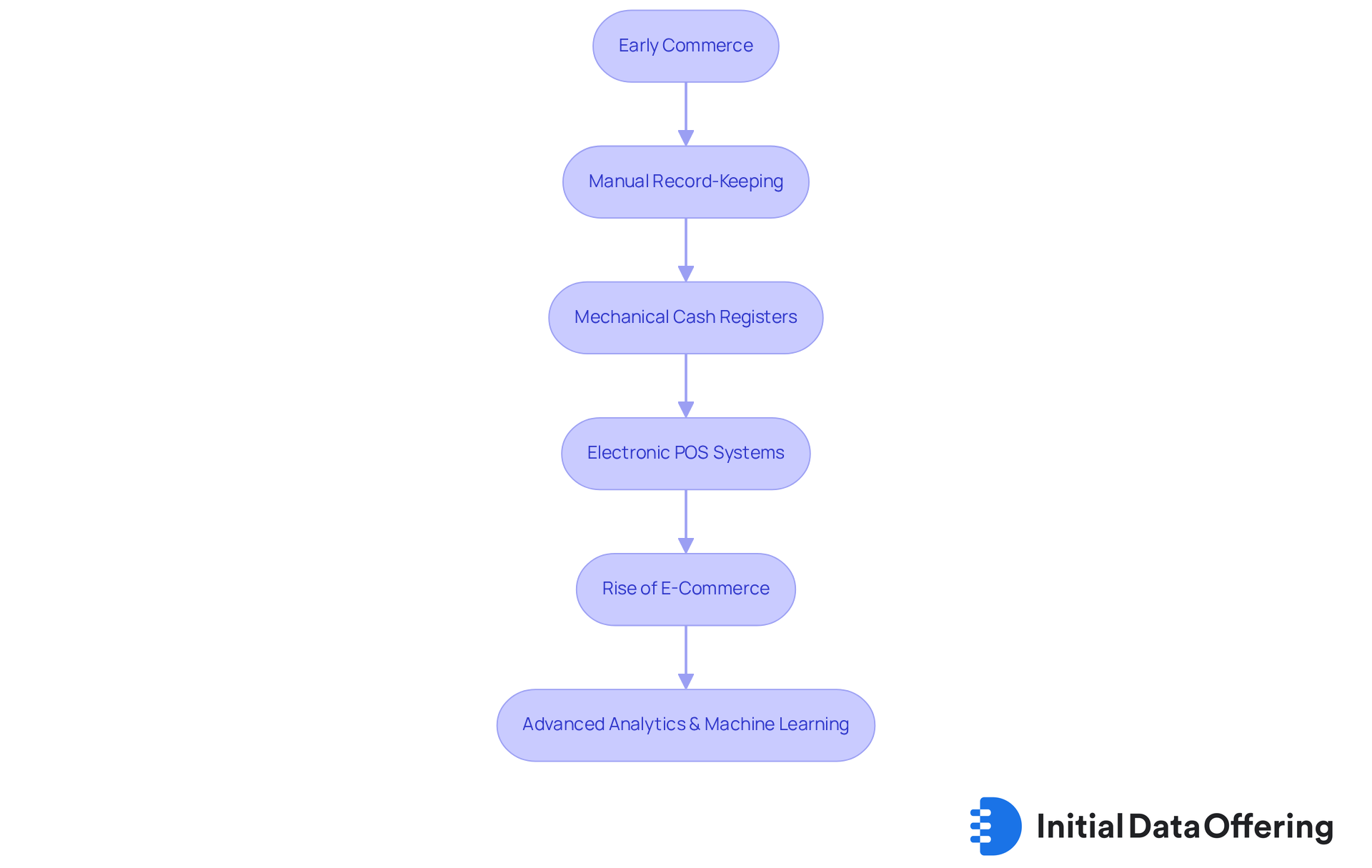
Explore Types of Retail Data: Categories and Applications
Retail data encompasses several categories, with each serving unique roles that are vital for effective management and growth. Key categories include:
-
Sales Data: This category includes detailed information on transactions, such as product specifics, quantities sold, and revenue generated. The advantage of sales data lies in its ability to evaluate performance and spot trends. For instance, U.S. retail transactions reached $7.26 trillion in 2024, reflecting a 2.70% rise from the prior year. This highlights the significance of monitoring metrics to assess market health. Additionally, retail sales in the U.S. increased by 0.6% month-over-month in June 2025, providing a timely perspective on recent performance trends.
-
Client Data: This category offers insights into client demographics, preferences, and purchasing behaviors. By examining client information, merchants can customize their products and promotional tactics, thereby improving customer interaction and loyalty. For example, recognizing that 18.4% of total retail sales in early 2024 were linked to e-commerce can assist businesses in enhancing their online presence. This underscores the increasing significance of online retailing in current market dynamics.
-
Inventory Data: This includes information on stock levels, turnover rates, and supply chain metrics. The precise inventory information is essential for efficient management, assisting merchants in preventing stockouts and excess inventory scenarios. In 2024, U.S. brick-and-mortar stores sold $5.93 trillion in merchandise, highlighting the need for precise inventory tracking to meet consumer demand.
-
Market Data: This encompasses broader insights into market trends, competitor performance, and economic indicators. Market information assists in strategic planning and positioning within the competitive landscape. For example, the anticipated increase of U.S. retail sales to over $8.29 trillion by 2030 illustrates the importance for sellers to remain aware of market dynamics.
By comprehensively understanding these categories, retailers can leverage data to enhance operational efficiency, drive growth, and make informed decisions that align with market demands. How can you utilize these insights to improve your business strategies?
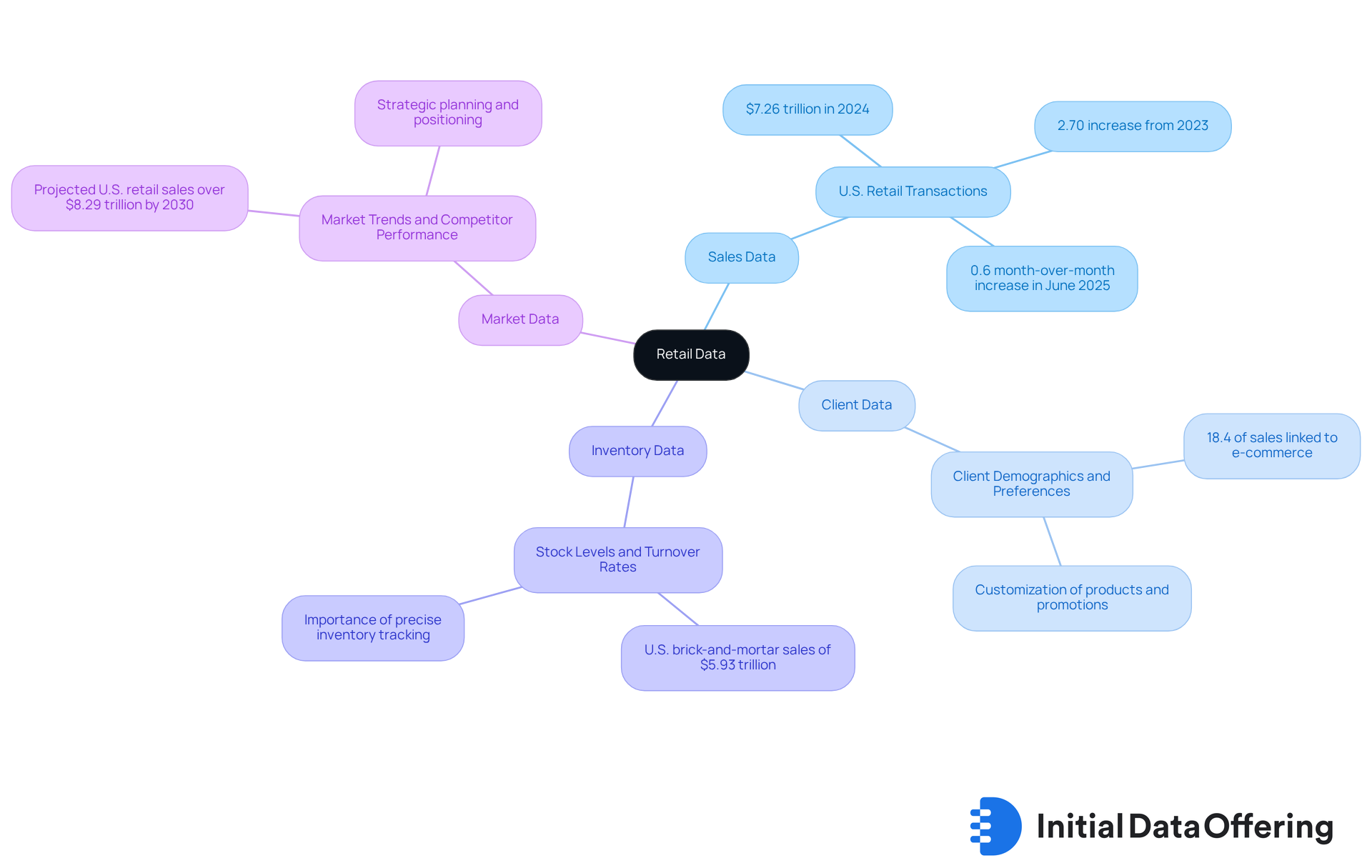
Conclusion
Retail data serves as a critical foundation for businesses seeking to enhance operational efficiency and improve customer experiences. By understanding and leveraging various components of retail data—such as sales metrics, client demographics, and inventory levels—retailers can make informed decisions that align with consumer expectations and market trends. This comprehensive approach not only optimizes inventory management but also fosters loyalty through personalized marketing strategies.
The significance of retail data is underscored throughout the article, particularly regarding its role in market research, the evolution of data collection methods, and the diverse types of retail data available. Key insights reveal that effective utilization of retail data can lead to better audience segmentation, improved customer engagement, and ultimately, increased revenue. The historical context highlights how advancements in technology, especially through POS systems and analytics, have transformed the way retailers gather and interpret data.
In an ever-evolving retail landscape, the ability to harness retail data effectively is paramount. Businesses are encouraged to explore the potential of retail data analytics to remain competitive and responsive to changing consumer behaviors. By investing in data-driven strategies, retailers can enhance their operational capabilities and create more meaningful interactions with their customers, solidifying their position in the market.
Frequently Asked Questions
What is retail data?
Retail data includes details collected from various transactions and consumer interactions within the retail environment, such as revenue statistics, client demographics, inventory levels, and buying patterns.
What role does point-of-sale (POS) information play in retail data?
POS information captures transaction details at the moment of sale, providing immediate insights into sales performance and helping retailers recognize trends and adjust inventory accordingly.
How does retail data enhance client experience?
Retail data allows sellers to recognize trends, adjust inventory to ensure favored items are available, and customize marketing strategies based on consumer preferences, ultimately enhancing customer satisfaction.
What percentage of sellers are using automation for inventory management?
A recent study indicates that 93% of sellers are utilizing automation for inventory management, which correlates with enhanced client satisfaction.
How can merging client information with sales metrics benefit retailers?
Merging client information with sales metrics can create a more tailored shopping experience, fostering customer loyalty and boosting sales.
What percentage of loyalty program engagement information is significant for retailers?
Loyalty program engagement information accounts for 55%, aiding merchants in rewarding and retaining devoted clientele.
Why is understanding retail data components important for retailers?
Understanding the components of retail data, particularly POS statistics, is essential for optimizing operations and enhancing customer experiences, helping businesses make informed decisions aligned with consumer expectations and market trends.
What is the projected growth of the retail analytics sector?
The retail analytics sector is projected to grow from USD 8.75 billion in 2024 to USD 31.08 billion by 2032, highlighting the increasing importance of effective information management and analysis solutions.